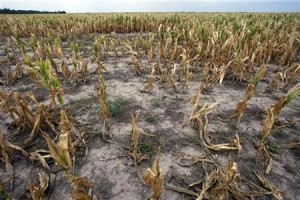Global Food Reserves Falling As Drought Wilts Crops
Stockpiles of the biggest crops will decline for a third year as drought parches fields across three continents, raising food-import costs already forecast by the United Nations to reach a near-record $1.24 trillion.
Combined inventories of corn, wheat, soybeans and rice will drop 1.8 percent to a four-year low before harvests in 2013, the U.S. Department of Agriculture estimates. Crops in the U.S., the biggest exporter, are in the worst condition since 1988, heat waves are battering European crops and India’s monsoon rainfall already is 20 percent below normal. The International Grains Council began July by forecasting record harvests. It ended with a prediction for a 2 percent drop in output.
The speed of the destruction drove corn and soybean prices to records last month and wheat to a four-year high. For investors, crops are the best-performing commodities this year, and Goldman Sachs Group Inc., Macquarie Group Ltd. and Credit Suisse Group AG say the trend will continue. The UN expects food costs to rise, less than two years after record prices pushed 44 million people into extreme poverty and contributed to uprisings in North Africa and the Middle East.
“People thought we were going to be swimming in corn by the end of the year,” said Kelly Wiesbrock, who helps manage $1.3 billion of assets for Harvest Capital Strategies, a San Francisco-based hedge fund. “Then the month of June hit and into July, and it’s just been a train wreck.”
Top Commodities
Wheat gained 41 percent to $9.1825 a bushel this year on theChicago Board of Trade, soybeans appreciated 31 percent to $15.8725, and corn rose 27 percent to $8.205. They were the biggest advances in the Standard & Poor’s GSCI Spot Index of 24 raw materials, which increased 2.2 percent.
The U.S. drought in June was the widest since December 1956 and the past 12 months were the hottest on record, weather data show. While the USDA anticipated a record harvest as recently as June, it cut the domestic corn forecast by 12 percent on July 11, the most since at least 1990. The estimate will be reduced again when the department reports Aug. 10, according to the average of 29 analyst forecasts compiled by Bloomberg.
The American drought is spreading beyond agriculture into power and fuel production. U.S. nuclear plants’ output on July 27 was the lowest for the day since 2001 because water was too hot to be an effective coolant, government data show. Parched conditions will spread into North Dakota and central Texas through October and last across the Midwest, the main growing region, the Camp Springs, Maryland-based Climate Prediction Center said Aug. 2.
Ethanol Mandate
More than 150 lawmakers urged President Barrack Obama on Aug. 2 to cut the government mandate for ethanol production, saying high corn costs are hurting livestock producers, food makers and consumers. Ethanol makers including Poet LLC and Archer Daniels Midland Co. (ADM) back the mandate, as mounting industry losses curbed daily output by 15 percent since the end of December, Energy Department data show.
The lack of rain is also pressuring natural-gas drillers to conserve the millions of gallons of water used in hydraulic fracturing to free trapped gas and oil from underground rock. Environmentalists in Texas are lobbying lawmakers to pass water- conservation laws next year. In Pennsylvania, the Susquehanna River Basin Commission suspended water intake for companies including Talisman Energy Inc. and Chesapeake Energy Corp. (CHK) on July 16.
Read more on Bloomberg









